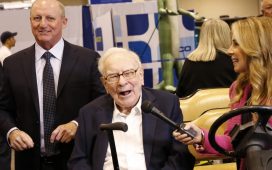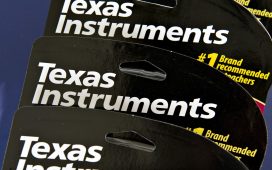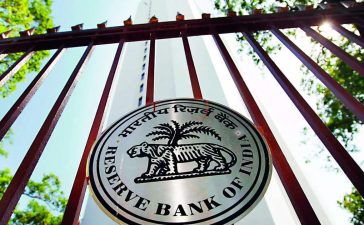The Texas Instruments Inc. logo is seen on scientific calculator packages in Tiskilwa, Illinois.
Daniel Acker | Bloomberg | Getty Images
Company: Texas Instruments (TXN)
Business: Texas Instruments is a global semiconductor company. The company designs, manufactures, tests and sells analog and embedded processing chips for markets, including industrial, automotive and personal electronics. Texas Instruments’ segments include Analog and Embedded Processing. Analog’s product lines include Power and Signal Chain. Power includes products that help customers manage power in electronic systems. Signal Chain includes products that sense, condition and measure real-world signals to allow information to be transferred or converted for further processing and control. The Embedded Processing segment includes microcontrollers, digital signal processors and applications processors. Texas Instruments also offers DLP products, which are primarily used to project high-definition images, as well as calculators and certain custom semiconductors known as application-specific integrated circuits.
Stock Market Value: $177.55B ($195.01 per share)
Texas Instruments’ 2024 performance
Activist: Elliott Investment Management
Percentage Ownership: 1.4%
Average Cost: n/a
Activist Commentary: Elliott is a very successful and astute activist investor. The firm’s team includes analysts from leading tech private equity firms, engineers, operating partners – former technology CEOs and COOs. When evaluating an investment, the firm also hires specialty and general management consultants, expert cost analysts and industry specialists. Elliott often watches companies for many years before investing and has an extensive stable of impressive board candidates. The firm has historically focused on strategic activism in the technology sector and has been very successful with that tactic. Over the past several years, its activism group has grown. The firm has been doing a lot more governance-oriented activism, creating value from a board level at a much larger breadth of companies.
What’s happening
On May 28, Elliott announced that it has taken a $2.5 billion position in Texas Instruments. It is calling on the company to adopt a dynamic capacity-management strategy and introduce a free cash flow per share target of $9.00+ in 2026.
Behind the scenes
Texas Instruments is one of the most iconic semiconductor companies in the world, with a history dating back nearly a century. It was a pioneering company that invented numerous pillars of modern technology, including the integrated circuit in 1958, the handheld electronic calculator in 1967 and the digital signal processor in 1978. Today, Texas Instruments offers approximately 80,000 unique products in support of more than 100,000 customers with a portfolio of analog and embedded semiconductor offerings. The company positioned itself as a strategic and operational leader following decades of thoughtful strategic decisions and focusing on high-performance analog, one of the stickiest and highest-margin markets in semiconductors.
Over the years, Texas Instruments has differentiated itself with a commitment to manufacturing as a core competitive advantage. It was the first analog semiconductor company to invest in 300-mm wafer production technology more than 15 years ago, which gave them a 40% cost-per-chip advantage relative to legacy 200-mm production. Today, Texas Instruments sources 80% of wafers internally, of which 40% are cost-advantaged 300-mm wafers. This investment in 300-mm technology resulted in gross margin expansion from 54% in 2010 to 63% in 2023. Additionally, the company has the world’s biggest footprint of geopolitically dependable 300-mm analog manufacturing capacity, with 47% of global capacity outside of China and Taiwan and 85% of capacity in the U.S.
Even though Texas Instruments has the No. 1 position in analog semiconductors, 74% exposure to the most attractive end markets (automotive and industrial), software-like margins (approximately 60% gross margins and approximately 40% operating margins), geopolitical security and company-owned manufacturing capacity, it has significantly underperformed peers in recent years.
Elliott points the finger at the one metric that Texas Instruments has focused on for years as the best indicator of value and management performance – free cash flow per share.
Elliott points out that the company’s history supports this core principle: It grew free cash flow per share at an annual rate of 17% from 2006 to 2019 while the stock generated a roughly 440% total return, outperforming the S&P 500 by about 200% and analog semiconductor peers by around 135% during the period.
During this time, prior to 2021, Texas Instruments spent an average of about $650 million per year in capex over the preceding decade, representing 5% of revenue. Then, the firm spent $2.5+ billion per year in 2021 and 2022. In 2022, the company announced that it would expand its manufacturing capacity with a plan that ultimately called for six new 300-mm fabrication facilities in the U.S. This plan calls for spending $5 billion per year through 2026 and several billion dollars annually thereafter, equating to 23% of revenue, and would nearly triple Texas Instruments’ internal manufacturing capacity by 2030. What did this do to free cash flow per share? Last year, the company generated only $1.47 per share in free cash flow – 77% lower than the prior year and 76% lower than five years ago. It’s also below the free cash flow per share generated at the depths of the 2008-2009 financial crisis, when Texas Instruments’ revenue was 40% below what it is today.
Elliott does not have a problem with the company increasing capex to accommodate future growth and the 2022 plan, when announced, was not necessarily wrong. However, in 2022, consensus expectations for 2026 revenue were $26 billion. Today, expectations have declined by 24% to $20 billion, which has Texas Instruments now spending billions of dollars to build to a 50% excess capacity. Elliott is asking for the company to do what it had done for years and what the industry does and what economic logic dictates – to modulate capex spend based on demand. Elliott does not even take credit for this plan; the firm uses the company’s own history as a blueprint. In 2003, Texas Instruments chose a site in Richardson, Texas to build the world’s first 300-mm analog fab, known as RFAB 1, in the midst of a semiconductor industry downturn. The company said that it would initially build the facility’s shell and then gradually outfit the facility with equipment in accordance with customer demand, as the equipment is 80% of the cost of the plant and a shell building could be fully equipped within six months to meet demand. RFAB 1 largely sat dormant for the next roughly five years and shipped its first products for revenue from in 2010, with Texas Instruments’ management frequently saying that RFAB “will ramp up consistent with demand.”
Elliott suggests that the company adopt a dynamic capacity-management strategy and introduce a free cash flow per share target of $9.00+ in 2026, representing a level that is about 40% above current investor expectations. The firm thinks that a commitment to prudent capital discipline will restore investors’ confidence, while providing Texas Instruments with flexibility to achieve this target through a combination of strong organic growth, market share gains and sensible capacity management. Elliott is not asking the company to cut 2024 or 2025 capex. The firm simply recommends that the company decrease 2026 capex to $2.75 billion if there is no increase in consensus revenue projections or keep it at $5.0 billion if Texas Instruments can increase its market share by 250 basis points. In either case, Elliott thinks the company can achieve $9.01 of free cash flow per share.
The company’s capex plan has decimated free cash flow per share and is building to a 50% excess capacity. Elliott’s plan restores the free cash flow per share growth and still builds to a 30% or 39% excess capacity. The company might argue that Elliott is being a “short-term minded activist,” but Elliott’s plan creates short-term value without sacrificing any long-term opportunities or value. It arguably creates more long-term value than the company’s plan. Texas Instruments’ performance and capex plan is exacerbated by its poor market communication. Free cash flow is down 77% due to an aggressive capex plan, and the company has not publicly laid out a detailed plan or made a case as to why they need 50% excess capacity.
This is such an easy ask, one has to wonder why Elliott has not worked this out with management before having to resort to a public letter. The firm supports the company’s strategy. It supports management, and it supports capex for 2024 and 2025, but there is no evidence that Elliott requested a meeting with management prior to sending this letter. Sometimes the process is as important as the content, and Elliott would have a much better chance of persuading management had it approached the company privately.
A proxy fight at a company like this would be a Herculean task for any activist, but if there is any activist with the resources and conviction to do it, it is Elliott. Given the firm’s reasonable ask and its support for management outside of this one inexplicable capex decision, we would expect this to settle amicably. We do not see Elliott getting one of their people on this board, but it could use some independent industry executives. Elliott does not go into a situation like this without a Rolodex of industry professionals with whom it consults and who would be available for board duty. If the company thinks it can ignore Elliott, it would be mistaken. But if Texas Instruments needs any additional evidence of Elliott’s conviction outside of the firm’s history, Elliott has built a $2.5 billion position here, which is big by even the firm’s standards.
Ken Squire is the founder and president of 13D Monitor, an institutional research service on shareholder activism, and the founder and portfolio manager of the 13D Activist Fund, a mutual fund that invests in a portfolio of activist 13D investments.











